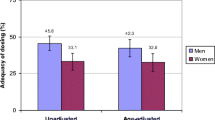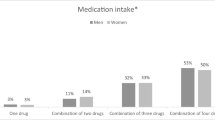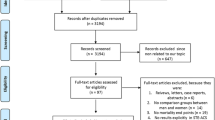Abstract
Background
Little is known about the prognosis associated with statin therapy and its gender differences in older adults aged ≥80 years.
Objective
To study the mortality and survival associated with statin therapy and their gender differences in older adults aged ≥80 years.
Method
This was a historical prospective study conducted at a tertiary medical center. The medical charts of all older adults aged ≥80 years who had been admitted to a single internal medicine department during 1 year were reviewed. All-cause 3‑year mortality and survival rates following hospital admission in men and in women using statins were investigated.
Results
The final cohort included 216 patients: 122 (56.5%) women, mean age 85.3 ± 3.9 years. Overall, 66 (53.2%) women and 58 (46.8%) men used statins for 3 years or more following hospital admission. During this time 48 (39.3%) women and 48 (51.1%) men died. The all-cause 3‑year mortality rates were significantly lower only in women who had used statins compared with women who had not used statins (24.2% vs. 57.1%; relative risk = 0.2; 95% confidence interval 0.1–0.5; p < 0.0001). The 3‑year cumulative survival rates were significantly higher in women who had used statins as part of primary as well as secondary cardiovascular prevention (p < 0.0001 and p = 0.014, respectively). A Cox regression analysis showed that statin therapy was independently associated with low 3‑year cumulative mortality rates in women (hazard ratio=0.3; 95% confidence interval=0.1–0.6; p = 0.001).
Conclusion
In older adults aged ≥80 years, statin therapy is associated with high 3‑year cumulative survival rates only in women.
Zusammenfassung
Hintergrund
Über die mit einer Statintherapie assoziierte Prognose und die Geschlechtsunterschiede bei älteren Menschen (≥80 Jahre) ist wenig bekannt.
Ziel
Ziel war es, die Mortalitäts- und Überlebensrate sowie die Geschlechtsunterschiede bei einer Statintherapie bei älteren Menschen (≥80 Jahre) zu untersuchen.
Methode
Eine historische prospektive Studie wurde in einem tertiären medizinischen Zentrum durchgeführt. Es erfolgte die Überprüfung der Patientenakten aller älteren Patienten (≥80 Jahre), die im 1. Jahr einer einzelnen Abteilung für Innere Medizin zugewiesen wurden. Die 3‑Jahres-Mortalität jeglicher Ursache und die Überlebensraten nach Krankenhauseinweisung bei Männern und Frauen, die Statine einnahmen, wurden untersucht.
Ergebnisse
In die finale Kohorte wurden 216 Patienten eingeschlossen, davon 122 (56,5%) Frauen (mittleres Alter: 85,3 ± 3,9 Jahre). Insgesamt nahmen 66 (53,2%) Frauen und 58 (46,8%) Männer Statine für 3 Jahre oder länger nach einer Krankenhauseinweisung ein. Während dieser Zeit starben 48 (39,3%) Frauen und 48 (51,1%) Männer. Die 3‑Jahres-Mortalitätsrate jeglicher Ursache war nur bei Frauen, die Statine einnahmen, signifikant geringer als bei Frauen, die keine Statine einnahmen (24,2% vs. 57,1%; relatives Risiko: 0,2; 95% Konfidenzintervall [CI] 0,1–0,5; p < 0.0001). Die kumulative Überlebensrate war signifikant höher bei Frauen, die als Teil der kardiovaskulären Primär- und Sekundärprävention Statine einnahmen (p < 0,0001 bzw. p = 0,014). Eine Cox-Regressionsanalyse zeigte, dass eine Statintherapie unabhängig mit einer geringeren 3‑Jahres-Mortalitätsrate bei Frauen assoziiert war (Hazard-Ratio 0,3; 95% CI 0,1–0,6; p = 0,001).
Schlussfolgerung
Bei älteren Menschen (≥80 Jahre) ist eine Statintherapie nur bei Frauen mit einer hohen kumulativen 3‑Jahres-Überlebensrate assoziiert.



Similar content being viewed by others
References
Naci H, Brugts JJ, Fleurence R, Tsoi B, Toor H, Ades AE (2013) Comparative benefits of statins in the primary and secondary prevention of major coronary events and all-cause mortality: a network meta-analysis of placebo-controlled and active-comparator trials. Eur J Prev Cardiol 20(4):641–657
Depp CA, Jeste DV (2006) Definitions and predictors of successful aging: a comprehensive review of larger quantitative studies. Am J Geriatr Psychiatry 14:6–20
Eaton CB, Lapane KL, Murphy JB, Hume AL (2002) Effect of statin (HMG-Co-A-Reductase Inhibitor) use on 1‑year mortality and hospitalization rates in older patients with cardiovascular disease living in nursing homes. J Am Geriatr Soc 50:1389–1395
Gränsbo K, Melander O, Wallentin L, Lindbäck J, Stenestrand U, Carlsson J, Nilsson J (2010) Cardiovascular and cancer mortality in very elderly post-myocardial infarction patients receiving statin treatment. J Am Coll Cardiol 55:1362–1369
Strandberg TE, Pitkala KH, Tilvis RS (2008) Statin treatment is associated with clearly reduced mortality risk of cardiovascular patients aged 75 years and older. J Gerontol A Biol Sci Med Sci 63:213–214
Allen Maycock CA, Muhlestein JB, Horne BD, Carlquist JF, Bair TL, Pearson RR, Li Q, Anderson JL, Intermountain Heart Collaborative Study (2002) Statin therapy is associated with reduced mortality across all age groups of individuals with significant coronary disease, including very elderly patients. J Am Coll Cardiol 40:1777–1785
Jacobs JM, Cohen A, Ein-Mor E, Stessman J (2013) Cholesterol, statins, and longevity from age 70 to 90 years. J Am Med Dir Assoc 14:883–888
Rothschild DP, Novak E, Rich MW (2016) Effect of statin therapy on mortality in older adults hospitalized with coronary artery disease: a propensity-adjusted analysis. J Am Geriatr Soc 64:1475–1479
Lloyd SM, Stott DJ, de Craen AJ, Kearney PM, Sattar N, Perry I, Packard CJ, Briggs A, Marchbank L, Comber H, Jukema JW, Westendorp RG, Trompet S, Buckley BM, Ford I (2013) Long-term effects of statin treatment in elderly people: extended follow-up of the Prospective Study of Pravastatin in the Elderly at Risk (PROSPER). PLOS ONE 8:e72642
Glynn RJ, Koenig W, Nordestgaard BG, Shepherd J, Ridker PM (2010) Rosuvastatin for primary prevention in older persons with elevated C‑reactive protein and low to average low-density lipoprotein cholesterol levels: exploratory analysis of a randomized trial. Ann Intern Med 152:488–496
Farahani P (2014) Sex/gender disparities in randomized controlled trials of statins: the impact of awareness efforts. Clin Invest Med 37:E163
Stone NJ, Robinson JG, Lichtenstein AH, Bairey Merz CN, Blum CB, Eckel RH, Goldberg AC, Gordon D, Levy D, Lloyd-Jones DM, McBride P, Schwartz JS, Shero ST, Smith SC Jr, Watson K, Wilson PW (2014) 2013 ACC/AHA guideline on the treatment of blood cholesterol to reduce atherosclerotic cardiovascular risk in adults: a report of the American College of Cardiology/American Heart Association Task Force on Practice Guidelines. J Am Coll Cardiol 63(25 Pt B):2889–2934
Kjekshus J, Apetrei E, Barrios V, Böhm M, Cleland JG, Cornel JH, Dunselman P, Fonseca C, Goudev A, Grande P, Gullestad L, Hjalmarson A, Hradec J, Jánosi A, Kamenský G, Komajda M, Korewicki J, Kuusi T, Mach F, Mareev V, McMurray JJ, Ranjith N, Schaufelberger M, Vanhaecke J, van Veldhuisen DJ, Waagstein F, Wedel H, Wikstrand J, CORONA Group (2007) Rosuvastatin in older patients with systolic heart failure. N Engl J Med 357:2248–2261
Allen M, Canadian Academic Detailing Collaboration (2006) Statins in primary prevention: uncertainty in women, elderly. Am Fam Physician 73:973–974
Owen A (2006) Life expectancy of elderly and very elderly patients with chronic heart failure. Am Heart J 151:1322.e1–1322.e4
Kuzuya M, Izawa S, Enoki H, Okada K, Iguchi A (2007) Is serum albumin a good marker for malnutrition in the physically impaired elderly? Clin Nutr 26:84–90
Author information
Authors and Affiliations
Corresponding author
Ethics declarations
Conflict of interest
D. Justo, M. Tchernichovsky, A. Kremer, E. Joffe, S. Sherman, M. Ioffe and H. Mayan declare that they have no competing interests.
This contribution depicts a historical prospective study which does not interfere with therapy.
Rights and permissions
About this article
Cite this article
Justo, D., Tchernichovsky, M., Kremer, A. et al. Gender differences in mortality among statin users aged 80 years or more. Z Gerontol Geriat 51, 882–888 (2018). https://doi.org/10.1007/s00391-017-1335-y
Received:
Revised:
Accepted:
Published:
Issue Date:
DOI: https://doi.org/10.1007/s00391-017-1335-y




